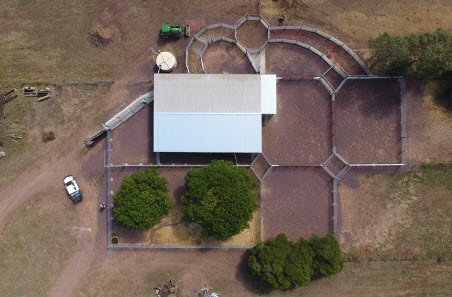Many happy returns on yard investment
13 July 2017

Cattle producers Marcus and Louise Richardson recently invested $170,000 in a new set of steel cattle yards to replace 50-year-old timber yards on their property ‘Larakoona’, located at Table Top, NSW.
The investment included $20,000 for gravel, $10,000 for earthworks to prepare the site, extensive concreting and roofing, and a dust-suppression sprinkler system.
Built by Holbrook Engineering in a design partnership with Thompson Longhorn, the yards feature a prefabricated rotary crowd pen and race.
Why invest?
Marcus said he had five ‘tactical’ reasons for investing in new yards rather than modifying the existing yards:
- Design flaws in the old yards
- Lack of durability in the old yard materials
- Improvements in yard design that could be incorporated in a new set of yards
- Modifying the old yards would lead to compromises and not allow extensive site preparation
- Cash flow and tax planning.
“The original yards tended to work against cattle behaviour rather than with it,” Marcus said.
“Some of the gates didn’t swing, some sliding gates didn’t slide and some of the gates were in the wrong place, which meant cattle flow was not ideal.
“There were a number of other limitations that all added up to inefficiency, inconvenience and frustration, as well as compromised safety.”
Marcus said his decision to make such a large investment in infrastructure was driven by a number of factors.
“My wife and I took over the business from my parents three years ago, after I had worked for them for about 10 years,” he said.
“Ideally, I wanted to get some big projects done early in our business ownership and we were lucky the profit we made last year allowed us to do that.
“I could have put the money elsewhere, but our fencing, pastures and machinery are all in reasonable condition. I would like to expand the business in terms of scale, but that opportunity hasn’t arisen yet.
“I also could have put it into superannuation for the future, but I chose to invest in creating a better work environment for today.
“I’m 44, so I have about 20 years left in the business. There would be no point making a big investment in my work environment five years before retirement. This way I get to enjoy the full benefit of it.”
In terms of return on investment, Marcus said while the yards provide a pay-off in reduced stress on stock due to less time spent in the yards and reduced bruising, the main return is emotional.
“It’s more about the emotional wellbeing that comes from reduced frustration caused by the inefficiency of the old yards, and the reassurance of knowing safety has been improved, which affects family, employees and visitors,” he said.
Lessons learned
- It’s important to do your own homework, but you don’t have to reinvent the wheel. Listen to the yard builders and design experts and take advantage of their knowledge.
- Don’t rush and don’t feel you have to go with the first yard design presented. The designers and I went back and forth and had about eight design versions before the final one.
More information
Marcus Richardson
E: marcusgrichardson@gmail.com
More Beef from Pastures manual module on herd health and welfare www.mbfp.mla.com.au
MLA’s Beef cattle feedlots: design and construction manual is available at www.mla.com.au by searching ‘feedlot design manual’.


